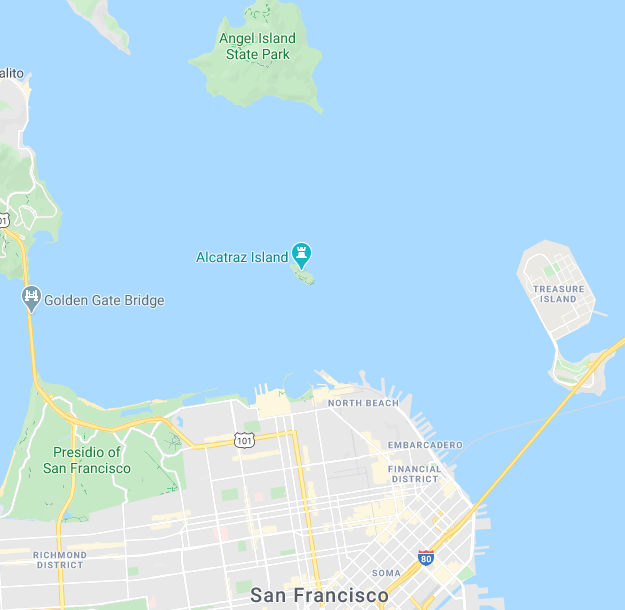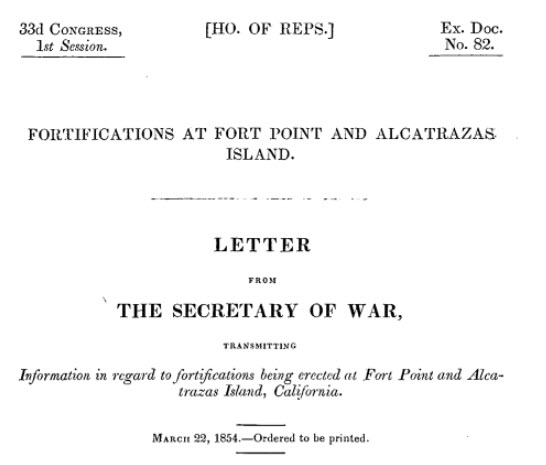This month, HeinOnline continues its Secrets of the Serial Set series by examining the history of Alcatraz Federal Penitentiary, one of America’s most notorious federal prisons.
Secrets of the Serial Set is an exciting and informative monthly blog series from HeinOnline dedicated to unveiling the wealth of American history found in the United States Congressional Serial Set. Join us each month to explore notable events in U.S. history using the primary sources themselves. Grab a seat and prepare to be blown away by what the Serial Set has to offer.
About the Serial Set
The United States Congressional Serial Set is considered an essential publication for studying American history. Spanning more than two centuries with more than 17,000 bound volumes, the records in this series include House and Senate documents, House and Senate reports, and much more. The Serial Set began publication in 1817 with the 15th Congress, 1st session. U.S. congressional documents prior to 1817 are published as the American State Papers.
The Serial Set is an ongoing project in HeinOnline, with the goal of adding approximately four million pages each year until the archive is completed. View the current status of HeinOnline’s Serial Set project by clicking the button below.
The Island of Pelicans
Little over a mile off the coast of California, a small yet notorious island rests in the San Francisco Bay. Long before the Golden Gate Bridge occupied the Bay skyline, the coastal area was settled by a complex system of Muwekma Ohlone tribes. Believing this tiny island to be haunted by evil spirits, the Ohlone people mostly avoided it, only visiting to gather food or, perhaps, to isolate tribe members who had violated a tribal law.
In 1775, Spanish explorer Juan Manuel de Ayala circumnavigated the bay, calling the land where the Ohlone resided Isla de los Angeles, or Angel Island. As he happened upon the smallest of the Bay’s landmasses, Alaya noted an abundance of pelicans nesting along the otherwise barren coast. He named the island Isla de los Alcatraces (Island of the Pelicans), known today as Alcatraz Island. As Spanish settlers and missionaries flocked to Southern California in the following years, the native Ohlone used the island to escape forced conversion to Christianity.

As the years went on, the Spanish Empire continued to conquer parts of North America, consolidating its American colonies under the Viceroyalty of New Spain. By the early 1800s, however, both Mexico and Central America declared their independence. Former Spanish territories, including Alcatraz Island, were placed under the rulership of the new Mexican Empire.
In 1848, the Treaty of Guadalupe Hidalgo ended the Mexican-American War and forced Mexico to relinquish the territory of California to the United States. Simultaneously, gold was discovered near San Francisco, initiating the California Gold Rush and thus an influx of visitors to the San Francisco region. As the area surrounding the island began to boom, President Millard Fillmore ordered that Alcatraz be reserved as a military base to protect the region.
Fort Alcatraz
The U.S. Army Corps of Engineers began fortifying the island under the direction of Zealous B. Tower. In 1854, the West Coast’s first lighthouse was built on the island’s rocky mountain peak. Along with Fort Point and Lime Point, Fort Alcatraz was to create a triangle of defense that would guard the entrance to the bay. Lime Point, however, was ultimately never constructed.

By 1861, Alcatraz Island hosted a defensive barracks—known as “the Citadel”—as well as nearly a hundred cannons around its perimeter, making it one of the most powerful Pacific Coast defenses. The natural isolation provided by Alcatraz Island led it to become a useful location for hiding both firearms and prisoners from the Civil War. When Abraham Lincoln suspended the writ of habeas corpus* in 1863, the island was further used to imprison private citizens and soldiers who had been accused of treason (Confederate sympathy or anti-Union activities).
In April of 1865, news that the Civil War had ended reached San Francisco by telegraph, and forts around the San Francisco Bay loosed their guns in celebration. Unfortunately, another telegraph came later that month bearing the news of President Lincoln’s assassination. Celebrations turned to riots, and Fort Alcatraz soldiers were called into the city to maintain order. While pro-Confederate citizens were gathered and imprisoned on the island, the fort issued a cannon shot over the bay every half hour in honor of the late president.
*Learn more about Lincoln’s suspension of habeas corpus with this sourcebook.

The end of the war brought rapid changes to artillery and fortification, leaving much of Alcatraz obsolete. Efforts to modernize the island’s defenses were undertaken in the 1870s—including a plan to level the entire island—but were never finished. Instead, buildings were rebuilt in brick and the island was officially designated as a long-term military prison. Throughout the late 1800s, the prison held many Native Americans, particularly members of the Hopi tribe. Following the Spanish-American War in 1898, the prison population on Alcatraz boomed, requiring that another prison complex be built.
Alcatraz Federal Penitentiary
In 1915, after the prison had been transferred to the Department of Labor, it was renamed “the Pacific Branch, U.S. Disciplinary Barracks.” The name did not last long, however—soon, nationwide changes required a reconsideration of the island’s purpose. Organized crime skyrocketed following the prohibition of alcohol in the 1920s, and the country fell into a severe economic depression in the 1930s. In response, Alcatraz was transformed into a less costly “last resort” prison, intended to house the most troublesome criminals. The island was renamed Alcatraz Federal Penitentiary and transferred to the jurisdiction of the Department of Justice.

In August of 1934, the first batch of more than a hundred prisoners was escorted from the U.S. Penitentiary in Kansas to Alcatraz Island. Guarded by 60 FBI agents, U.S. Marshals, and other security officials, the group consisted of notorious murderers, bank robbers, counterfeiters, and other criminals, including the FBI’s “Public Enemy No. 1,” gangster Al Capone—also known as Scarface. By its first anniversary, Alcatraz Federal Penitentiary held more than 240 prisoners, including George “Machine Gun” Kelly, Alvin “Creepy Karpis” Karpowicz, and Robert Stroud, who would become known as the “Birdman of Alcatraz” due to his penchant for ornithology.
Known as the toughest and most fearsome prison in America at the time, the penitentiary remained open and operating for nearly 30 years. The country’s most dangerous criminals were met with allegedly inhumane conditions and brutality from the prison’s officers, giving rise to legends of inmate dismemberment, suicide attempts, and murders. During its operation, the prison’s official stance was that no prisoner had successfully escaped, though a total of 36 had tried. One failed attempt led to the Battle of Alcatraz, a violent interchange between prison staff and six prisoners who had gained access to the weapons room.
The most famous escape attempt, later dramatized in film, may have actually succeeded despite official reports. Three prisoners chipped away at the salt-damage concrete of one wall with homemade tools, creating an escape route through a nearby air vent. They planned to crawl through the vent to the roof, and then sail to the mainland on a homemade inflatable raft fashioned out of raincoats. When it came time to implement the plan, the prisoners left papier-mâché dummies in their beds and successfully departed Alcatraz. It is unclear what happened next—the FBI report concludes that the escapees drowned, but the three men remain on the U.S. Marshals Service’s wanted list.
Alcatraz, the Park
A year later, following the report of a Commission on the Disposition of Alcatraz, the island was deemed too costly to maintain as a federal prison. The buildings were severely eroding due to saltwater saturation, food and water were expensive to ship in, and three people may have escaped regardless of the prison’s isolated location. Alcatraz Federal Penitentiary was closed, leaving a barren island with crumbling buildings and a haunted past.
As the civil rights movement gained momentum over the next few years, the desolate landmass became a symbol for Native Americans. On three separate occasions, groups of Native Americans occupied the island, in an attempt at reclaiming their rightful land. In 1969, one of those occupations lasted for nearly two years. During this time, many of the remaining buildings were graffitied or destroyed by fire. The federal government assumed a stance of non-interference.
In 1972, the Nixon administration passed a law to create the Golden Gate National Recreation Area, designating more than 82,000 acres (including Alcatraz Island) as protected parkland. Later, the island was declared a National Historic Landmark. Now, Alcatraz is a popular tourist attraction as well as a place for Native American ceremonial gatherings. To this day, visitors report ghost sightings and other supernatural activity on Alcatraz, causing the island to be cited as one of the most haunted places in America.
Check back next month to unveil another secret of the U.S. Congressional Serial Set with HeinOnline. While you wait, catch up on previous Secrets of the Serial Set. Alternatively, learn more about how to use HeinOnline’s Serial Set with our in-depth LibGuide.
For more great content, connect with us on our social media platforms: Facebook, Twitter, Instagram, and YouTube.



